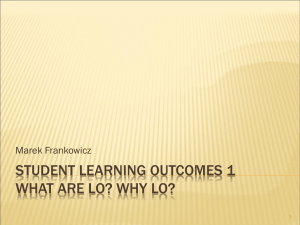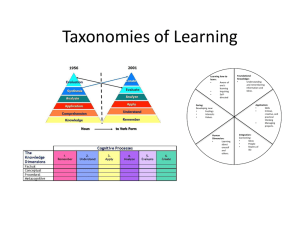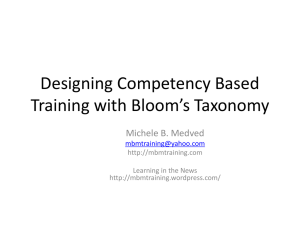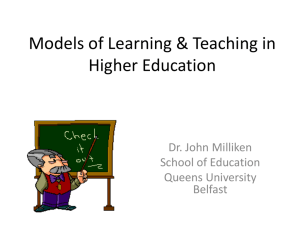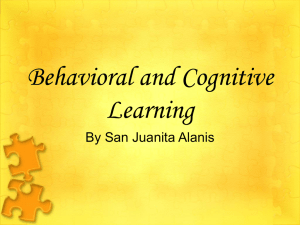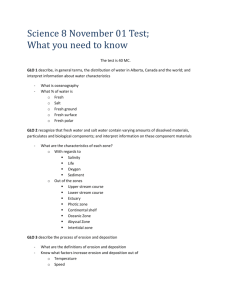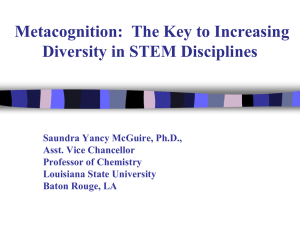here - Glow Blogs - Education Scotland
advertisement
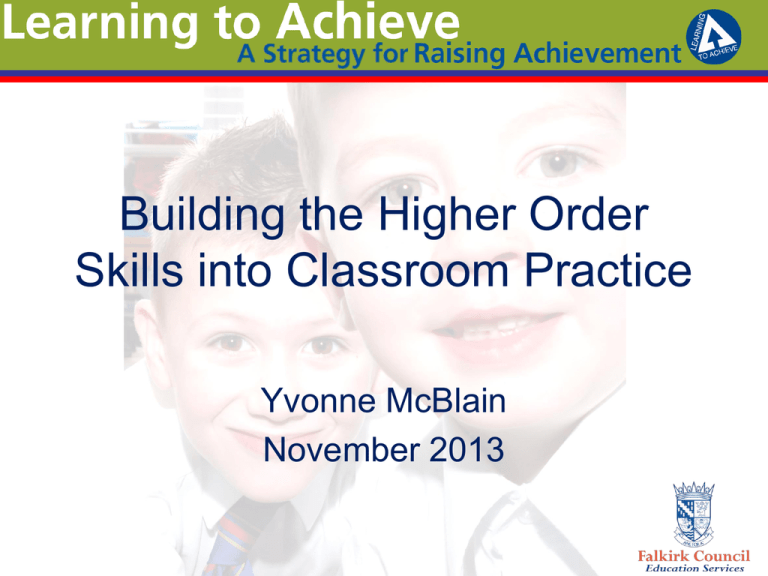
Building the Higher Order Skills into Classroom Practice Yvonne McBlain November 2013 Learning Intentions Participants will: • Develop their knowledge of the higher order skills & taxonomies • Deepen understanding of how these transferable skills can be built into learning experiences Success Criteria • How would you like to measure the success of this session? • ? • ? • ? Success Criteria Participants will: • Have increased knowledge of the Higher Order Skills • Analysed how skills taxonomies can impact on planning • Identified how the HOS are built into the E & Os • Increase their ability to integrate HOS into learning intentions within their teaching • Have increased awareness of relevant next steps in their application of the HOS What will we do? • • • • • • • • What are the Higher Order Skills? Sharing of practice and thinking Looking at Bloom’s Taxonomy & its revision Finding the skills in the E & O s What are taxonomies for? Planning with a taxonomy Assessment and HOS What do your learners need to know about HOS? Skills Focus – why? • http://glo.li/1iHw95Q - A range of people describe the importance of skills • CfE & 4 Capacities are designed to develop young people who: • Are aware of which skills they are developing • Have the ability to describe and measure their own skills progression. • Can see how (& when) these skills will be useful to them What are the Higher Order Skills? • What is a taxonomy? How might a taxonomy be useful? • Keir Bloomer explains http://glo.li/Hws8FX • “Using a taxonomy of thinking skills to plan and reflect on learning opportunities can ensure that learners are challenged. Exploring these skills can help learners to develop a set of generic or transferable skills that will help them cope with the challenges of future learning, life and work.” Education Scotland Higher Order Skills • Not just aiming for low order recall to pass exams and assessments • Aiming for deep understanding – the ability to transfer and apply flexibly to any context • Metacognition and self-awareness in our learners Higher Order Skills Excellence Paper • Highlighting the skills component in every learning situation • Emphasising the importance of skills to learning, life and work • Using a common language to describe skills across the curriculum • Challenging learners to value and advance their own skills • Equipping learners to evaluate and take ownership of their skills • Assessing and recording skills in a way that enables learners to demonstrate what they can do and plan for further development http://www.scotland.gov.uk/Resource/Doc/920/0121113.pdf Bloom’s Taxonomy 1956 Anderson and Krathwohl 2001 • Revision of Bloom’s taxonomy • More relevant for planning, delivery and assessment • Breaks Bloom’s categories down into a wider range of verbs Activity • Take out the Bloom’s Taxonomy Triangle and the set of activities • In your groups discuss each activity and match it to a skill Things to remember They are not: • Hierarchical – early level learners are just as capable of developing HOS as more sophisticated learners – provided the learning is planned and paced properly. • Sequential – learning experiences don’t necessarily have to address every stage/skill. Learning experiences using these skills may not always be in order. Bloom’s Question Starter Fans • Do these help us ask “good” questions? • How could they help your planning? • How do you already use these in your classroom? Let’s collect & record ideas Let’s Build a Bloom’s So how useful is Bloom’s? • Yes or No? • How and when? • Why? Reasons for using a taxonomy Helps educators: • examine objectives from the student’s point of view • consider the panorama of possibilities… learning how to learn • see the integral relationship between knowledge & cognitive processes inherent in objectives (Research Report 10, SQA – Using Taxonomies in Assessing Higher-Order Skills 2008) Reasons for using a taxonomy 2 • Makes life easier – examiners can easily identify the “demand” of a question… • Makes more readily apparent the consistency, or lack of it, among the stated objectives for a unit, the way it was taught, and how learning was assessed • Helps educators make better sense of the wide variety of terms that are used in education – the precision in the taxonomy improves communication and understanding of what is to be taught and assessed. The NAR Planning Flowchart The Planning Triangle (E + O) ÷ HOS = ELT? • Let’s find an E or O which “contains” a higher order skill THEN analyse it to pinpoint: • Action/Verb – what will pupils do? • Knowledge/Content – what are they learning? • Skills development and transfer? • Context – how is the learning being “packaged”? ((E + O) ÷ HOS) + AfL = ELT LI = We are developing understanding of HOS Task = Write a learning intention for your E & O which would enable your pupils to develop one of the higher order skills SC – Product - I can write a learning intention which explains which HOS is being developed Process SC • Has no context • Selects & develops a relevant part of your E & O • Uses language your pupils can understand How do we assess HOS? • What do you do already? • What could you do as well – or instead? • How do these actions fit with your existing processes? • How would they impact on your work load? HOS Taxonomy • What is synthesis? • http://glo.li/1gr8zO2 Keir Bloomer • What is systems thinking? • http://glo.li/187hAnj Keir Bloomer • http://glo.li/187huvW Skills taxonomy Other taxonomies • Skills Pathway • HOS Excellence Group • SOLO http://glo.li/1gtPRWe • SQA Framework Further reading? • SQA paper • http://glo.li/18a01Tv • Learning Intentions & Success Criteria http://glo.li/VICKSN • High Order Skills Excellence Group Report • http://glo.li/qqIpnR • Developing Skills Pack • http://glo.li/18a09ma Further information: • National Assessment Resource • https://www.narscotland.org.uk/IntraLibrary?command=external -shib-login • Education Scotland IDL advice • http://www.educationscotland.gov.uk/learningteachingandasses sment/learningacrossthecurriculum/interdisciplinarylearning/ind ex.asp • Education Scotland Approaches to Learning advice • http://www.educationscotland.gov.uk/learningteachingandasses sment/approaches/index.asp

